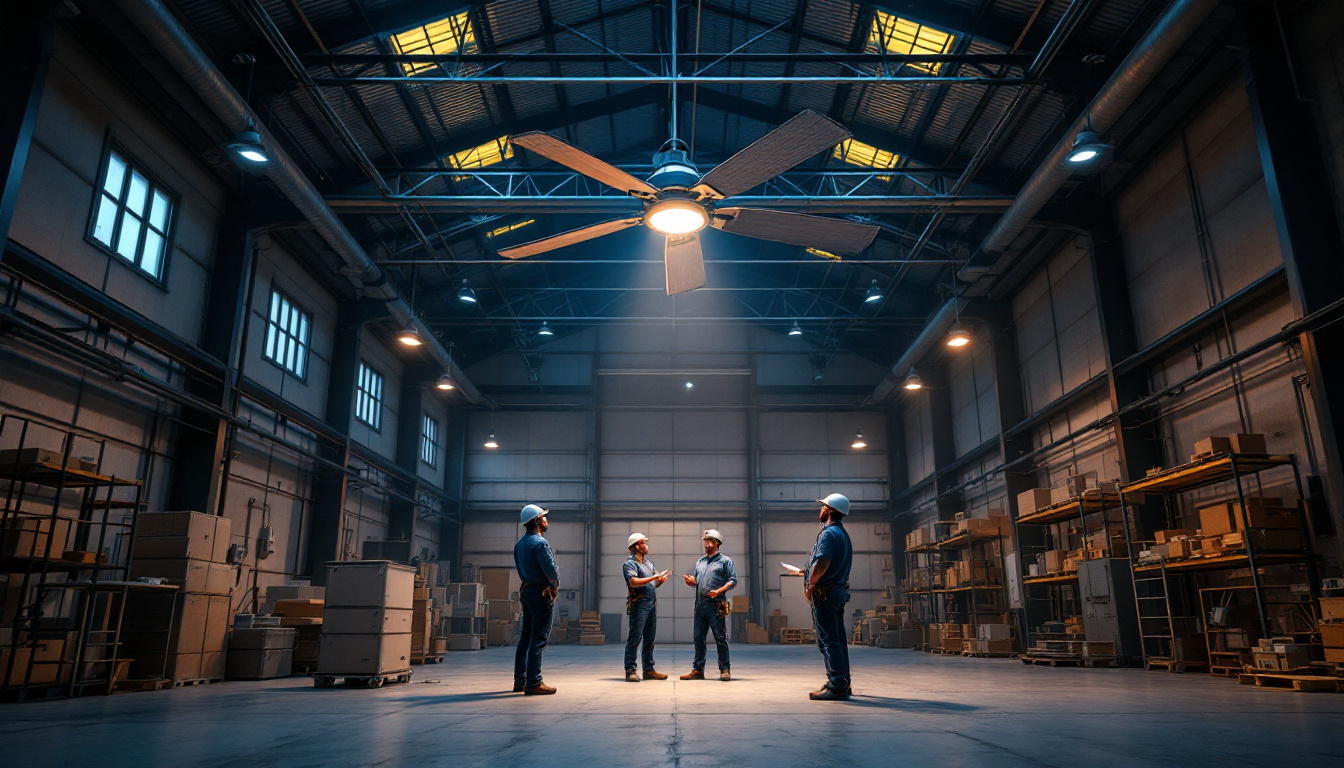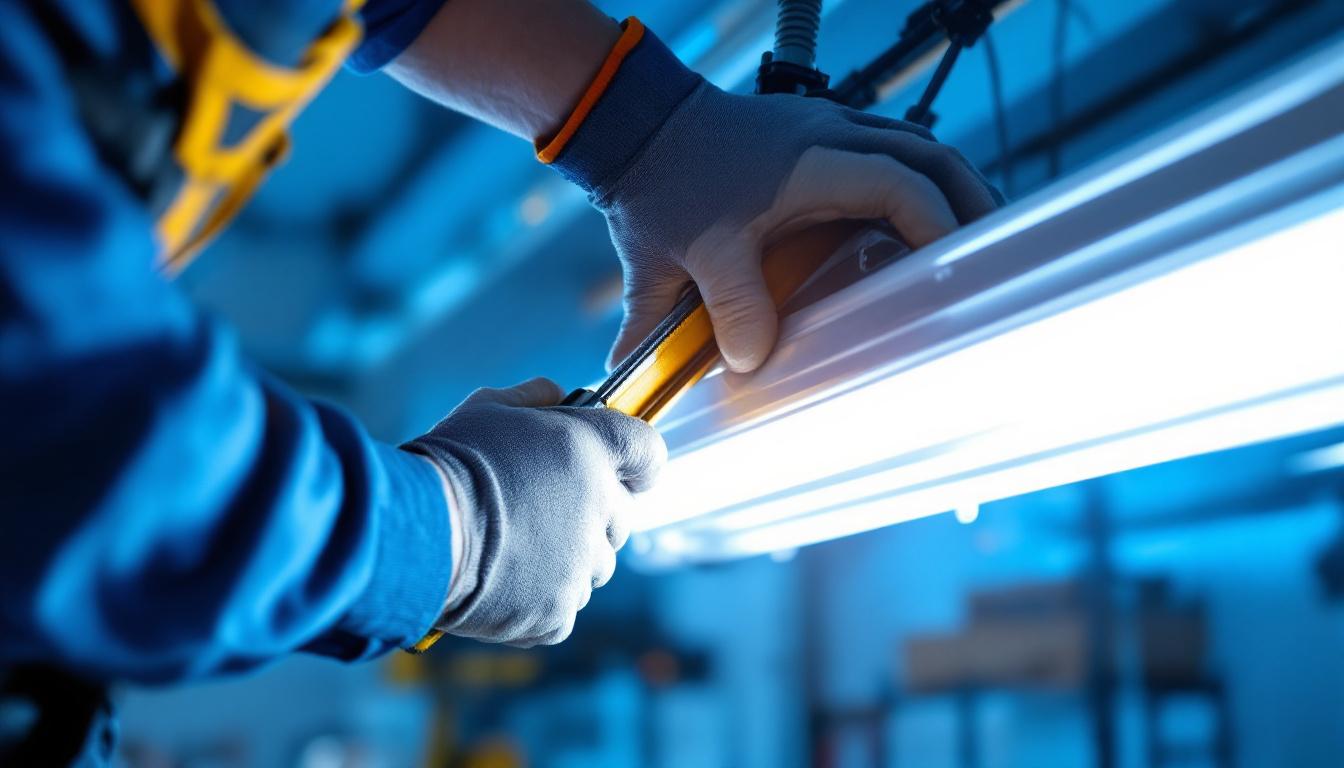
In the realm of industrial settings, the importance of proper ventilation and air circulation cannot be overstated. As lighting contractors, understanding the role of industrial ceiling fans is essential not only for enhancing comfort but also for optimizing energy efficiency. This article delves into the various aspects of industrial ceiling fans, providing valuable insights that can aid lighting contractors in their projects.
Industrial ceiling fans serve a critical function in large spaces such as warehouses, factories, and retail environments. By promoting air circulation, these fans help maintain a consistent temperature throughout the space, making it more comfortable for employees and customers alike. Additionally, they can significantly reduce energy costs by decreasing the reliance on heating and cooling systems.
One of the primary benefits of industrial ceiling fans is their ability to regulate temperature. In large, open areas, hot air tends to rise, leaving cooler air near the ground. Industrial fans help to redistribute this air, ensuring a more uniform temperature. This is particularly important in environments where machinery generates heat or where large numbers of people congregate. Moreover, the strategic placement of these fans can create a wind-chill effect, enhancing comfort levels for workers engaged in physically demanding tasks. This not only boosts productivity but also contributes to overall employee satisfaction and retention.
Another advantage of using industrial ceiling fans is their energy efficiency. By improving air circulation, these fans can reduce the need for air conditioning in warmer months and heating in colder months. This not only lowers energy bills but also contributes to a more sustainable operation, which is increasingly important in today’s environmentally conscious market. In fact, many modern industrial fans are designed with advanced technology that allows them to operate at lower speeds while still delivering optimal airflow. This means that businesses can enjoy the benefits of enhanced ventilation without the high energy consumption typically associated with traditional HVAC systems.
In addition to temperature regulation and energy efficiency, industrial ceiling fans also play a vital role in improving indoor air quality. By facilitating constant air movement, these fans help to disperse airborne contaminants and prevent the stagnation of air, which can lead to the buildup of dust, allergens, and other pollutants. This is especially crucial in environments such as manufacturing plants or food processing facilities, where air quality can directly impact health and safety standards. Furthermore, the integration of filtration systems with industrial fans can further enhance air quality, ensuring that workers breathe cleaner air while performing their duties.
Industrial ceiling fans are not only functional but also versatile in design, making them suitable for a variety of settings. Available in different sizes, colors, and styles, these fans can seamlessly blend into the aesthetic of any industrial or commercial space. Some models even come equipped with smart technology, allowing for remote control and programmable settings, which can be tailored to the specific needs of the environment. This adaptability ensures that businesses can maintain both style and functionality, creating a more inviting atmosphere for employees and customers alike.
When selecting an industrial ceiling fan, several factors must be considered to ensure optimal performance. These include the size of the space, the height of the ceiling, and the specific needs of the environment.
The size of the fan is crucial in determining its effectiveness. A fan that is too small will struggle to circulate air adequately, while one that is too large may create excessive noise or draft. The blade span is typically measured in inches and should be chosen based on the square footage of the area. For example, a fan with a 52-inch blade span is suitable for spaces up to 400 square feet, while larger areas may require fans with spans of 72 inches or more.
Ceiling height is another critical factor in fan selection. Industrial ceiling fans are designed to operate efficiently at various heights, but the mounting height can affect performance. Ideally, the fan blades should be positioned 8 to 10 feet above the floor for optimal air circulation. In spaces with high ceilings, downrods may be necessary to achieve the appropriate height.
Proper installation of industrial ceiling fans is vital to ensure their effectiveness and longevity. Lighting contractors should adhere to specific best practices to maximize performance and safety.
There are various mounting techniques for industrial ceiling fans, including flush mount, downrod mount, and angled mount. The choice of mounting technique will depend on the ceiling height and the design of the fan. For instance, a downrod mount is ideal for high ceilings, while a flush mount may be more suitable for lower ceilings. Ensuring that the fan is securely mounted is crucial to prevent any accidents or damage.
Electrical considerations are equally important during installation. It is essential to ensure that the fan is connected to a suitable power source and that all wiring complies with local electrical codes. Additionally, integrating the fan with existing lighting controls can enhance functionality, allowing for synchronized operation and improved energy efficiency.
Regular maintenance of industrial ceiling fans is essential to ensure their continued performance. Lighting contractors should educate clients on the importance of routine inspections and cleaning to prolong the life of the fans.
Dust and debris can accumulate on fan blades over time, which can hinder performance and create an unappealing appearance. Regular cleaning is necessary to maintain efficiency. A simple dusting with a soft cloth or a vacuum attachment can remove buildup. For more thorough cleaning, fans can be turned off and wiped down with a damp cloth, ensuring that all surfaces are free from dirt.
In addition to cleaning, periodic inspections for wear and tear are crucial. Lighting contractors should check for any signs of damage, such as bent blades or loose connections. Addressing these issues promptly can prevent more significant problems down the line and ensure the fan operates safely and efficiently.
For lighting contractors, integrating industrial ceiling fans with lighting solutions can enhance both functionality and aesthetics. This integration can create a cohesive design while maximizing energy efficiency.
When selecting ceiling fans, it is essential to consider the overall design of the space. Fans come in various styles, colors, and finishes, allowing contractors to choose options that complement existing lighting fixtures. A well-coordinated design can enhance the overall aesthetic of the space, creating a more inviting environment.
Incorporating smart technology into ceiling fan and lighting systems can significantly enhance user experience. Many modern fans come equipped with smart features that allow users to control speed and lighting through mobile apps or voice commands. This level of integration not only adds convenience but also improves energy management, allowing for more precise control over air circulation and lighting levels.
Examining successful implementations of industrial ceiling fans can provide valuable insights for lighting contractors. These case studies highlight the benefits of proper fan selection, installation, and maintenance.
In a large warehouse setting, the implementation of industrial ceiling fans significantly improved air circulation, leading to a more comfortable working environment. The fans were strategically placed to create a consistent airflow, reducing the reliance on air conditioning during the summer months. As a result, the facility reported a noticeable decrease in energy costs, demonstrating the financial benefits of proper fan utilization.
A retail space that integrated industrial ceiling fans with existing lighting solutions saw an improvement in customer satisfaction. The fans not only provided comfort but also complemented the lighting design, creating an inviting atmosphere. Customers reported feeling more at ease while shopping, which ultimately contributed to increased sales. This case underscores the importance of considering both lighting and ventilation in retail environments.
The landscape of industrial ceiling fans is continually evolving, with new technologies and designs emerging to meet the needs of modern industries. Lighting contractors should stay informed about these trends to provide the best solutions for their clients.
As energy efficiency becomes increasingly important, manufacturers are developing more advanced fan models that consume less power while delivering superior performance. These energy-efficient models often incorporate features such as variable speed controls and improved blade designs, which can enhance airflow while reducing energy consumption.
Smart technology is set to play a significant role in the future of industrial ceiling fans. As more facilities adopt automation and smart building technologies, the integration of ceiling fans with building management systems will become more prevalent. This integration will allow for real-time monitoring and adjustments, optimizing energy use and enhancing overall comfort.
Industrial ceiling fans are a vital component in creating comfortable and energy-efficient environments in various settings. For lighting contractors, understanding the intricacies of fan selection, installation, and maintenance is essential for delivering comprehensive solutions. By staying informed about the latest trends and technologies, contractors can enhance their offerings, ensuring that clients receive the best possible outcomes for their industrial spaces.
Incorporating industrial ceiling fans into lighting projects not only improves air circulation but also contributes to a holistic approach to design and functionality. As industries continue to evolve, the role of lighting contractors in integrating these systems will only grow in importance, making it essential to keep abreast of advancements in both lighting and ventilation technologies.
Ready to elevate your lighting projects with the best industrial ceiling fans on the market? Look no further than LumenWholesale, where we provide contractors with superior, spec-grade lighting products at unbeatable wholesale prices. Our selection of industrial ceiling fans is designed to meet the highest industry standards, ensuring you deliver energy-efficient and high-performance solutions to your clients. Take advantage of our hassle-free bulk buying options with free shipping and no hidden fees. Make your next project a breeze with the perfect blend of quality, affordability, and convenience at LumenWholesale – Wholesale Lighting at the Best Value.

Discover expert insights into LED light strip kits with our comprehensive guide tailored for lighting contractors.

Discover how Linear Light technology is revolutionizing the lighting industry, offering contractors innovative solutions for efficiency, design flexibility, and sustainability.

Discover why fluorescent tube tombstones are essential for lighting contractors.

Discover the step-by-step guide to replacing a fluorescent light ballast with expert tips from seasoned lighting contractors.